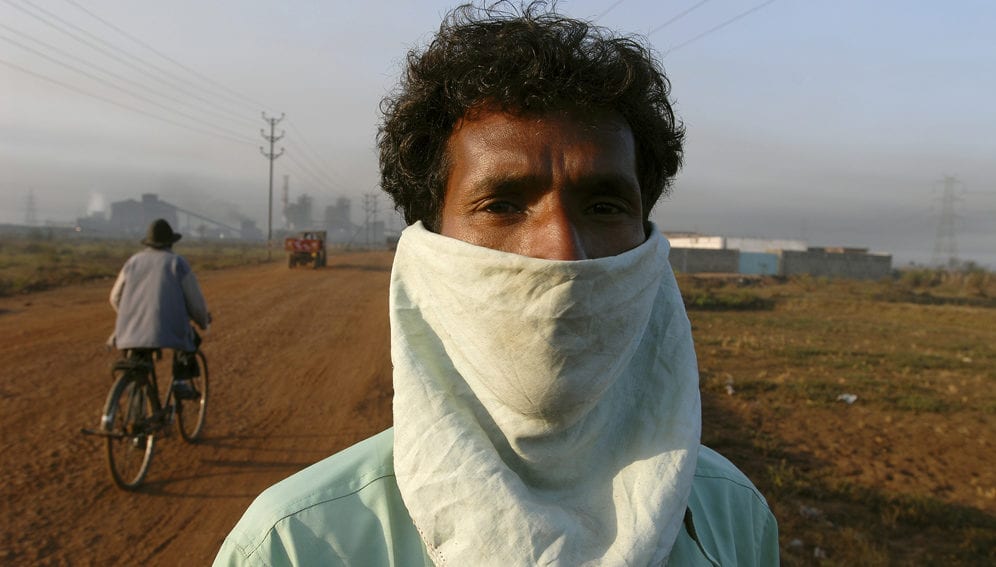By: Sanjeet Bagcchi
Send to a friend
The details you provide on this page will not be used to send unsolicited email, and will not be sold to a 3rd party. See privacy policy.
[NEW DELHI] In India, 1.24 million deaths, equivalent to 12.5 per cent of total fatalities in the country in 2017, were attributable to air pollution, making it a bigger contributor to disease than tobacco, says a study published this month (December) in The Lancet Planetary Health.
The study follows a World Health Organization (WHO) report in May which declared that nine out of the world’s top 10 polluted cities were in India.
“Air pollution has been found to be associated with [the] same disease end points affected by smoking.”
Kalpana Balakrishnan, WHO Collaborating Centre for Occupational and Environmental Health
The disability-adjusted life-year (DALY) rate — a measure of disease burden — was much higher for lower respiratory tract infections caused by air pollution than by tobacco use, according to the study. For diseases such as chronic obstructive pulmonary disease, ischemic heart disease and stroke, the DALY rates were higher with air pollution than tobacco.
“That air pollution is a bigger contributor to the disease burden than tobacco should not come as a surprise,” says Kalpana Balakrishnan, an author of the study and director at WHO Collaborating Centre for Occupational and Environmental Health, in Chennai, India. “Air pollution has been found to be associated with [the] same disease end points affected by smoking,” she tells SciDev.Net.
Study co-author Michael Brauer, professor at the University of British Columbia, Vancouver, Canada, says that tobacco is a bigger hazard for those who use it. Fortunately, most people do not use tobacco. “In contrast, everyone breathes — and within India that means everyone breathes polluted air. So from the perspective of the entire population, air pollution is a bigger contributor to ill health than tobacco."
Balakrishnan and colleagues looked at exposure to ambient particulate matter pollution (measured by annual average concentration of particulate matter smaller than 2.5 micrograms or PM 2.5) and household air pollution (measured by percentage of households using solid fuels for cooking). PM 2.5 penetrates the lungs and contributes to heart disease, stroke, lung cancer and respiratory ailments.
The researchers found that the annual population-weighted mean PM 2.5 in air was highest in Delhi (209·0 microgram per cubic metre), followed by Uttar Pradesh, Bihar, and Haryana (range: 125·7—174·7 microgram per cubic metre).
“Of the total population in India in 2017, 42.6 per cent of residents were exposed to mean PM 2.5 greater than 80 microgram per cubic metre and 76.8 per cent were exposed to mean PM 2.5 greater than 40 microgram per cubic metre, which is the limit recommended by the National Ambient Air Quality Standards in India,” the study said.
In 2017, about 55 per cent of the Indian population was using solid fuels. In some states such as Bihar, Jharkhand and Odisha, the figure was as high as 75 per cent.
In the same year, ambient particulate matter pollution caused 0.67 million deaths in India; 0.48 million deaths were ascribed to household air pollution. According to the researchers, the average life expectancy in India in 2017 would have been 1.7 years more — 2 years more in some states such as Haryana, Rajasthan and Uttar Pradesh — if the level of air pollution was less than the minimum causing health loss.
According to study co-author Sagnik Dey, associate professor at Indian Institute of Technology Delhi, the study signifies that India cannot achieve sustainable growth with such a large burden of air pollution. “Therefore, without any doubt, an inter-sectoral plan is required at the regional scale to combat air pollution.”
Edward Avol, professor of clinical preventive medicine at University of Southern California, US, tells SciDev.Net that because the number of people in India is high the denominator of people affected by poor air quality is very large. “This should be seen as both a burden and an opportunity, because improvements in air quality could also have measurable and substantive positive impacts on a large portion of the population.”This piece was produced by SciDev.Net’s Asia & Pacific desk.














